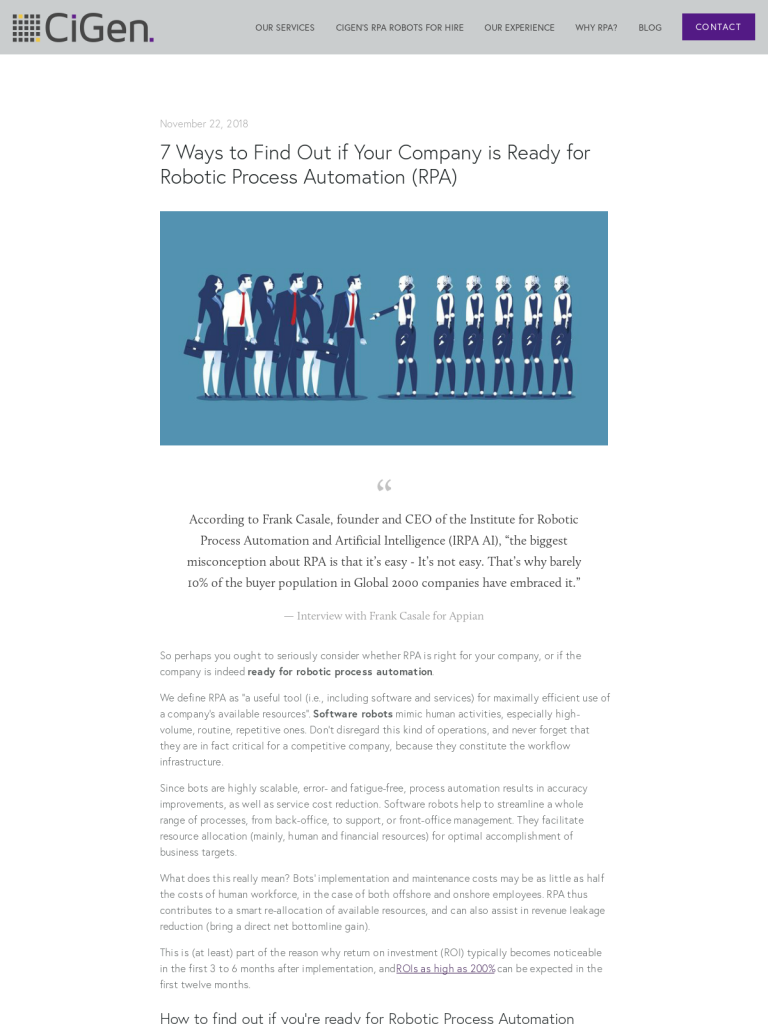7 Ways to Find Out if Your Company is Ready for Robotic Process Automation (RPA)
Original post from https://www.cigen.com.au/cigenblog/

“According to Frank Casale, founder and CEO of the Institute for Robotic Process Automation and Artificial Intelligence (IRPA AI), “the biggest misconception about RPA is that it’s easy – It’s not easy. That’s why barely 10% of the buyer population in Global 2000 companies have embraced it.””
So perhaps you ought to seriously consider whether RPA is right for your company, or if the company is indeed ready for robotic process automation.
We define RPA as “a useful tool (i.e., including software and services) for maximally efficient use of a company’s available resources”. Software robots mimic human activities, especially high-volume, routine, repetitive ones. Don’t disregard this kind of operations, and never forget that they are in fact critical for a competitive company, because they constitute the workflow infrastructure.
Since bots are highly scalable, error- and fatigue-free, process automation results in accuracy improvements, as well as service cost reduction. Software robots help to streamline a whole range of processes, from back-office, to support, or front-office management. They facilitate resource allocation (mainly, human and financial resources) for optimal accomplishment of business targets.
What does this really mean? Bots’ implementation and maintenance costs may be as little as half the costs of human workforce, in the case of both offshore and onshore employees. RPA thus contributes to a smart re-allocation of available resources, and can also assist in revenue leakage reduction (bring a direct net bottomline gain).
This is (at least) part of the reason why return on investment (ROI) typically becomes noticeable in the first 3 to 6 months after implementation, and ROIs as high as 200% can be expected in the first twelve months.
How to find out if you’re ready for Robotic Process Automation (RPA)
In what follows, we recommend 8 methods to help you decide whether or not your business is ready for robotic process automation.
1. Spot areas that call for improvement
Start with a thorough, realistic evaluation of all the departments in your company. Review the areas that consistently underperform and, of course, try to gain an understanding of the causes. For example, consider customer service in the front or back office. What processes in that area are affected by:
-
data access issues (i.e. time required to access data across multiple applications)
-
transcription errors causing medium to high error rates
-
manual data entry time
-
excessive approval time
2. Appraise the inter-departmental information flow
Turn your attention towards information silos, which might index an underlying dysfunctionality of information sharing across various departments. An important reason for such malfunctioning may be the existence of legacy and modern systems, respectively, in different areas of your company.
The corresponding communication bottlenecks could be hurdled by enlarging the scope of modernisation by means of implementing robotic process automation. In this sense, information silos point out that your business could benefit from robotic process automation.
3. Evaluate the stability of your business processes
As we said before, finding those processes that are well suited for automation is a prerequisite of the implementation procedure. Suitable processes are repetitive, rule-based, and quasi exception-free.
Software robots are not apt at exception handling, so they work best on highly stable processes. Therefore, you know your company is ready for RPA if you managed to single out a set of standardised activities that you can automate in a pilot.
Thank you. We will be in touch shortly.
4. Estimate the necessity of additional hirings
If you’re business is growing, you may reach a point when you realise that it’s not easy to keep up with the rhythm of development. For instance, you might have to hire more people. And the cost of additional hirings may account for a significant part of the difficulties.
The scalability of software robots recommends RPA as a less costly solution. If you also consider other advantages of robotic process automation, then again you have clear evidence of readiness for implementation, and even for scaling to enterprise level.
5. Assess the amount of manual tasks that your employees perform
If you end up with an impressively long list, your employees may get tired, bored, dissatisfied, and even burned-out from huge amounts of quasi-meaningless tasks. Also, a need for consistent data entry across various systems (e.g., such is the case in a finance company, which must produce financial statements, activate cards, open accounts, etc.) is a sign that your company can greatly benefit from RPA implementation.
6. Find out the level of your employees’ job satisfaction
To this end, you may use a standardised questionnaire, such as the Job Descriptive Index. What if the results are below expectations, despite your efforts to provide extrinsic motivations for your workers?
One likely cause of dissatisfaction is the perceived need to waste time with tedious administrative or other low-level tasks. Productivity drops are a direct, highly undesirable consequence. Robotic process automation might be the right tool for allowing workforce shifts to higher value tasks.
7. Estimate the cost of errors
This assessment comes as a natural consequence of point (5) above, simply because manual data entry is a reliable source of error. Furthermore, error calls for rework, and review and correction is time-consuming and expensive.
If error leads to delays and consequential headaches, it may mean that your company is ready for RPA. It might be worth reading about the questions that help you choose the right processes for RPA implementation.
Conclusion
Implementing RPA in your company brings tangible benefits: quick and large ROIs, reduced cybersecurity risks, easier data management, satisfied employees and customers. It is a great illustration of technology in the service of humans. And it offers a substantial competitive advantage for business innovators who are ready for robotic process automation.
Leave a Comment
You must be logged in to post a comment.








